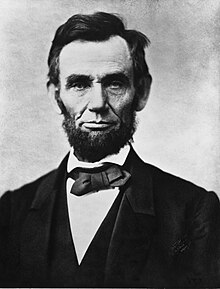
The American Civil War was a civil war in the United States between the Union and the Confederacy, which was formed in 1861 by states that had seceded from the Union. The central conflict leading to war was a dispute over whether slavery should be permitted to expand into the western territories, leading to more slave states, or be prohibited from doing so, which many believed would place slavery on a course of ultimate extinction.

Gettysburg is a borough in Pennsylvania and the county seat of Adams County, Pennsylvania, United States. As of the 2020 census, the borough had a population of 7,106 people.
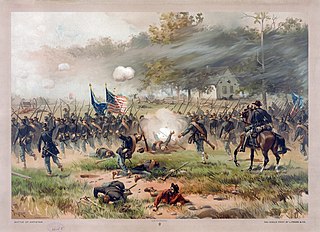
The Battle of Antietam, also called the Battle of Sharpsburg, particularly in the Southern United States, took place during the American Civil War on September 17, 1862, between Confederate General Robert E. Lee's Army of Northern Virginia and Union Major General George B. McClellan's Army of the Potomac near Sharpsburg, Maryland, and Antietam Creek. Part of the Maryland Campaign, it was the first field army–level engagement in the Eastern Theater of the American Civil War to take place on Union soil. It remains the bloodiest day in American history, with a tally of 22,727 dead, wounded, or missing on both sides. Although the Union Army suffered heavier casualties than the Confederates, the battle was a major turning point in the Union's favor.

Sharpsburg is a town in Washington County, Maryland. The town is approximately 13 miles (21 km) south of Hagerstown. Its population was 560 at the 2020 census.

Drum Barracks was the Union Army's headquarters for Southern California and New Mexico during the Civil War. It consisted of 19 buildings on 60 acres in what is now Wilmington, with another 37 acres near the waterfront. Its junior officers' quarters has been preserved as the Drum Barracks Civil War Museum. Its powder magazine stands on private property three blocks away, protected by a chain-link fence.
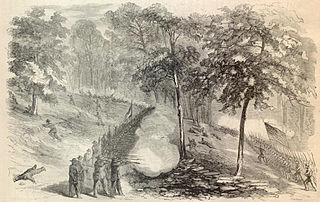
The Battle of South Mountain, known in several early Southern accounts as the Battle of Boonsboro Gap, was fought on September 14, 1862, as part of the Maryland campaign of the American Civil War. Three pitched battles were fought for possession of three South Mountain passes: Crampton's, Turner's, and Fox's Gaps.

Barbara Fritchie, also known as Barbara Frietchie, and sometimes spelled Frietschie, was a Unionist during the Civil War. She became part of American folklore in part from a popular poem by John Greenleaf Whittier.

There is widespread disagreement among historians about the turning point of the American Civil War. A turning point in this context is an event that occurred during the conflict after which most modern scholars would agree that the eventual outcome was inevitable. The near simultaneous Battle of Gettysburg in the east and fall of Vicksburg in the west, in July 1863 is widely cited as the military climax of the American Civil War. Several other decisive battles and events throughout the war have been proposed as turning points. The events are presented here in chronological order with only the positive arguments for each given.

Alexander Gardner was a Scottish photographer who immigrated to the United States in 1856, where he began to work full-time in that profession. He is best known for his photographs of the American Civil War, U.S. President Abraham Lincoln, and of the conspirators and the execution of the participants in the Lincoln assassination plot.
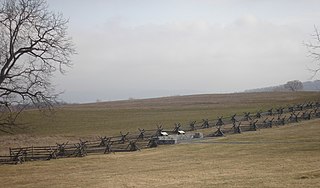
Antietam National Battlefield is a National Park Service-protected area along Antietam Creek in Sharpsburg, Washington County, northwestern Maryland. It commemorates the American Civil War Battle of Antietam that occurred on September 17, 1862.
David McConaughy was a noted attorney, state senator, cemetery president, and civic leader in Gettysburg, Pennsylvania and a part-time intelligence officer for the Union Army during the American Civil War. He was a driving force behind the creation of the Gettysburg National Cemetery following the Battle of Gettysburg. He also led early efforts to preserve the Gettysburg Battlefield for future generations.

The ghost of U.S. president Abraham Lincoln, also known as the White House Ghost, is said to have haunted the White House since Lincoln's assassination in 1865. Lincoln's ghost has also been said to haunt many of his former residences in Springfield, Illinois, including his former law office.

Being the site of military battles, deadly duels, assassinations, untimely deaths, and other associated tragedies, there are a number of reportedly haunted locations in Washington, D.C., the capital city of the United States.

The Rossborough Inn is a historic building facing Baltimore Avenue/United States Route 1 on the eastern edge of the campus of the University of Maryland at College Park. Construction on the building began in 1798 and was completed in 1803, making it the oldest building on campus and the oldest building in the adjoining town of the City of College Park. It is built in the Federal style. The lower wings were added in 1938, as part of extensive renovations. The Rossborough Inn is listed as a historic site by the Maryland-National Capital Park and Planning Commission.
The following are reportedly haunted locations in Pennsylvania:
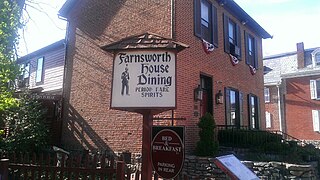
The Farnsworth House Inn is a bed and breakfast and tourist attraction located in Gettysburg, Pennsylvania. The building is purported to be haunted, which the business uses in its promotional literature. Apart from being an inn, the building has also served as a tourist home and shop.
The Civil War Trust's Civil War Discovery Trail is a heritage tourism program that links more than 600 U.S. Civil War sites in more than 30 states. The program is one of the White House Millennium Council's sixteen flagship National Millennium Trails. Sites on the trail include battlefields, museums, historic sites, forts and cemeteries.

The Bolivar Heights Battlefield in Jefferson County, West Virginia, partly in the town of Bolivar, is an American Civil War battlefield which, – because of its strategic position overlooking Harpers Ferry, where the U.S. had an armory, and its placement at the head of the Shenandoah Valley – was the site of five separate engagements between Union and Confederate forces: in October 1861, May and September 1862, June 1863, and July 1864. The battlefield lies partly on the 669-foot (204 m) Bolivar Heights plateau, but also includes School House Ridge to the west, and the slopes of both, which meet at Bakerton Road. The site was also used by the armies as a campground, and, in 1864, as a Union corral and wagon yard.
